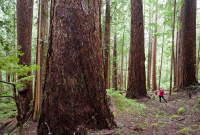Support strong Canadian climate journalism for 2025
A new government report on the state of Canadian forests shows that the area burned last year by fires jumped nearly three-fold compared to the year before.
In 2017, almost 3.4 million hectares of forest burned, up from the 1.4 million in 2016, said the latest analysis from Natural Resources Canada.
The numbers may be even higher in next year's report.
British Columbia saw a record-setting year in 2017 for fires, and then surpassed that record earlier this year, according to local officials.
Fires affected less than one per cent of Canada's 347 million hectares of forest, and were less of a problem than pests, which impacted about 4.5 per cent of all forested areas, down from five per cent in 2015.
The two threats to Canada's forest may only grow over the coming years as climate change creates conditions for more and stronger fires, as well as the spread of pests.
"If it gets drier — and we think that it's going to get warmer — you're creating conditions that could lead to more fire, longer fire seasons," said John Kozij, director general of trade, economics and industry at Natural Resources Canada.
"But also on top of that, pest disturbances are likely to be more significant ... as shorter winters can lead to broader pest disturbances."
The report says the combination of pests and forest fires is expected to challenge growth in the country's forestry sector, even as demand for Canada's softwood expands — especially from the growing U.S. housing market.
The report predicts continuing decline for paper products and warns of faster job losses in newsprint as a result of ongoing trade disputes with the U.S.
Forestry products account for 7.2 per cent of all Canadian exports, about $24.6 billion in economic activity and employs about 200,000 people nationally.
Kozij says there is potential for growth in an emerging bio-economy, pointing to recent advances that have led to wood being used in the construction of taller, more sustainable and energy efficient buildings.
The report says the vastness of Canadian forests has remained relatively stable for the past three decades.
Canada's 347 million hectares of forest make up about nine per cent of the planet's forest.
Much of it is in remote, sparsely populated areas, meaning it isn't under pressure to be cleared to make way for agriculture or urban development like in many other countries — which explains why its vastness hasn't changed much over the last three decades, says Kozij.





Comments
In 2015, total net emissions (emissions minus removals) of carbon dioxide equivalent (CO2e) from Canada's managed forests (65% of Canada's total forest area) were about 221 million tonnes (Mt).
(source: Natural Resources Canada, Sept 28, 2017, Indicator: Forest carbon emissions and removals)
Emissions from the "unmanaged" part of Canada's forest are not accounted for.
These emissions are the result of "natural disturbances" (e.g. wildfires, insect infestations such as the mountain pine beetle).
GHG emissions from "natural disturbances" are not accounted in Canada's annual report on GHG emissions.
Despite the fact that under the United Nations Framework Convention on Climate Change (UNFCCC), Canada must report annually on GHG emissions from Canada's "managed forest", Canada has decided not to report those emissions.
"Canada has indicated that its accounting for managed forest towards its emissions reductions target will exclude the impacts of natural disturbances because these impacts are non-anthropogenic."
(source: Canada's Second Biennial Report on Climate Change to the UNFCCC, April 2016, Section 5.1, footnote)